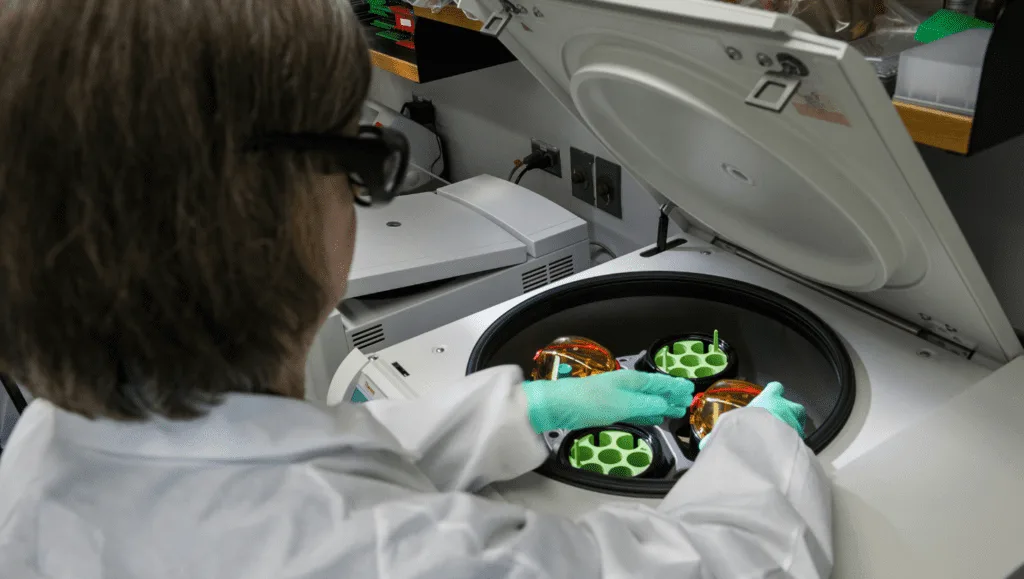Choosing the right centrifuge for your laboratory is a critical decision that impacts the success of your experiments. Centrifuges are indispensable tools in scientific labs, used to separate components of a sample based on their size, shape, and density. Whether you’re working in a clinical, research, or industrial setting, it’s essential to select the right model that meets your specific needs. In this article, we’ll walk you through the key factors to consider, such as RPM vs. RCF, tube sizes, bio-containment features, and more.
RPM vs. RCF: Understanding the Difference
A central consideration when choosing a centrifuge is the distinction between RPM (revolutions per minute) and RCF (relative centrifugal force). RPM measures the rotor speed, while RCF measures the actual force applied to the sample during centrifugation. In many applications, RCF is a more critical parameter because it reflects the true forces at play, which can affect the separation efficiency of your samples.
When selecting a centrifuge, it’s important to match the correct RCF setting for your specific application to achieve accurate and reliable results. Whether you’re working with delicate samples or robust biological materials, understanding the relationship between RPM and RCF ensures that your centrifuge performs optimally.
Why Tube Size Matters?
Tube size plays a significant role in the performance of your centrifuge. Selecting the right tube size ensures proper sample distribution and prevents damage to the machine. Using tubes that are too large or too small for the rotor can lead to inaccurate results or even damage the equipment.
At Apex Scientific, we offer a range of centrifuge models designed to accommodate various tube sizes, ensuring that your laboratory equipment remains versatile and efficient. Be sure to choose a centrifuge with the appropriate capacity for your sample volumes.
Typical Tube Sizes for the Cryste Centrifuge Range
When considering centrifuges for your laboratory, the Cryste range offers a variety of options tailored to handle commonly used tube sizes, such as:
- 1.5 mL to 50 mL tubes: These sizes are commonly used for applications like DNA/RNA extraction in molecular biology.
- 15 mL to 250 mL tubes: Ideal for larger volume samples such as blood separation or large-scale cell culture.
- Microplates and test tubes: Some centrifuge models come equipped with adapters for microplates or test tubes, adding to their versatility.
By choosing the right centrifuge from the Cryste range, available at Apex Scientific, you can rest assured that the machine will support the necessary tube sizes for your laboratory procedures. Learn more about the Cryste centrifuge models here.
Bio-Containment Lids: Safety First
For laboratories handling hazardous or biological samples, bio-containment lids are an essential safety feature. These lids prevent accidental exposure to airborne pathogens and harmful substances, ensuring that laboratory workers remain safe during centrifugation.
A centrifuge with an integrated bio-containment lid is especially important for environments with strict safety protocols, such as medical, pharmaceutical, or microbiological labs. If your laboratory deals with sensitive materials, ensure the centrifuge you select offers the necessary bio-containment features to meet safety standards.
Other Key Considerations
When selecting a centrifuge for your laboratory in South Africa, there are several other factors to take into account:
- Capacity: Whether you need a centrifuge for small or large volumes, you should select a model that can handle your workload. Larger-capacity models are available for high-volume labs, while benchtop units are ideal for smaller tasks.
- Rotor Design: Different rotor types offer different capabilities. Fixed-angle rotors are great for separating particles by size, while swing-out rotors are better suited for density-based separation.
- Speed Control: Precise speed control is crucial for adapting your centrifuge to specific applications. Choose a model that offers customizable settings to meet your lab’s needs.
- Noise and Vibration: If noise and vibration are important considerations for your work environment, select a model with noise-reduction features.
At Apex Scientific, we are committed to providing high-quality laboratory equipment to meet all of your centrifugation needs. Whether you’re looking for centrifuges for delicate biological samples or robust industrial applications, our products are designed for accuracy, efficiency, and safety.
Conclusion: Make the Right Choice for Your Laboratory
Selecting the right centrifuge involves careful consideration of factors like RPM vs. RCF, tube sizes, safety features, and application-specific requirements. At Apex Scientific, we are proud to offer top-tier centrifuge solutions from reputable suppliers like Cryste. If you are in South Africa and looking for reliable laboratory equipment, we are your trusted supplier for quality centrifuges and other essential laboratory tools.
To explore our range of centrifuges and find the perfect model for your needs, visit Apex Scientific’s centrifuge product page.




